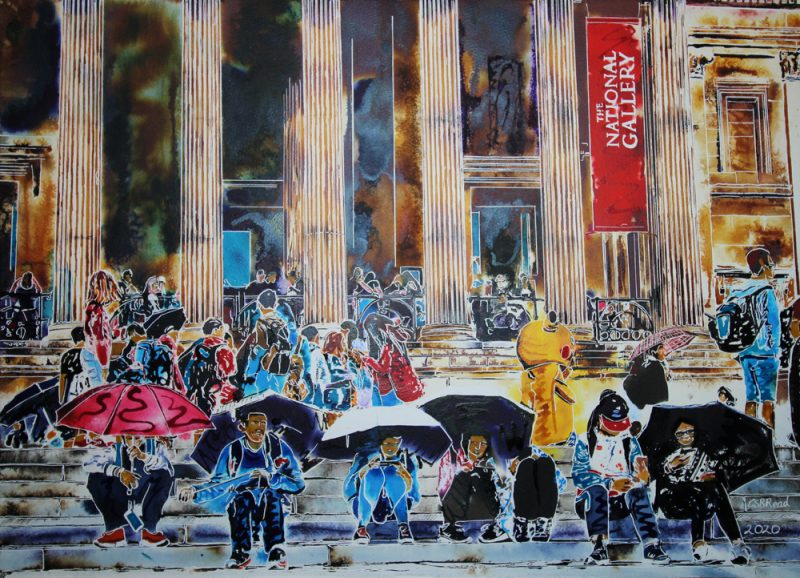Cultural Exchange. Remember London scenes like these? People milling around in close proximity. I’m sure they will return. But wearing more masks. Our culture has changed, and only time will tell what the new normal will be.
Why call the painting 'Cultural Exchange'?
We’re outside the National Gallery in London. A true mecca for cultural lovers.
The numbers do not lie. On average 6 million people visit its infamous halls each year, ranking as the UK’s second most popular tourist attraction. Worldwide, it is the 7th most popular visitor attraction. This should come as no surprise as the gallery curates treasured cultural artifacts – paintings and sculptures spanning centuries.
As usual, tourists from across the globe bunch outside hoping to enjoy these artistic culture within the building. But ‘Cultural Exchange’ also depicts many other 21st century cultural artifacts – smartphones, clothes, travel, architecture, and even Pikachu. Pikachu is a cultural icon from the manga tradition, which is popular worldwide, especially amongst the younger generations.
Cultural exchange is an ongoing and necessary part of life. Exchanges create a more beautiful and connected world. As we explore other cultures, traditions, artifacts…we learn that other people are just that – people. Different but possibly less alien that we imagined.
There are exchanges of ideas and styles in all we observe in this scene. From the inspiration behind the public building’s architecture that created the columns, to the seven students’ footwear and the eight umbrellas – each has a place in the painting.
A scene begging to be painted
This picture was begging to be painted – seven tourists sitting on the steps outside the National Gallery in Trafalgar Square.
Five teenagers engrossed in their phones, doing who knows what. Three huddled under an umbrella – white with black undersides. The girl in the red peaked cap and ponytail proudly holding hers. We can’t see her expression as her face is hidden behind the peak. The fifth girl is more concealed as she leans back on the steps; both hands clutching her phone. The two boys are focused on other things. One gazes off at some distant distraction while pulling on a cord. Or maybe they are earphones he is trying to disentangle, so that he can listen to music? The chap with a pink umbrella is more introspective. His phone dangles limply on a cord. These seven are part of the crowd.
Behind them are some of their companions mixed in with a general mass of tourists, museum visitors, and other Londoners. The ubiquitous crowd that can, or should I say, could be found anywhere in London – pre lockdown. Except perhaps for Pikachu. The yellow cartoon figure is incongruous amongst the regular crowd. And yet, is he?
Snapshots invite shared culture exchanges
London streets in tourist zones were once full of street performers, entertainers as varied as pavement artists, living statues, conjurers, jugglers, musicians – in every shape form and size. So even Pikachu has a place! Maybe I’ll even find out who he or she is one day. But for now, all I have is imagination.
Snapshots in time capture a moment. But that snapshot moment may be open to interpretation, influenced by the viewer’s culture and experience. I may create a thing, but the viewer will always approach it from their own personal perspective and find something new that had not entered my consciousness, at the time. And so – we exchange a shared experience.

